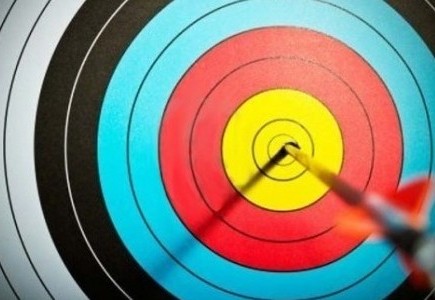Competitive Archery
Modern competitive archery involves shooting arrows at a target for accuracy from a set distance or distances. This is the most popular form of competitive archery worldwide and is called target archery. A form particularly popular in Europe and America is field archery, shot at targets generally set at various distances in a wooded setting. There are also several other lesser-known and historical forms, as well as archery novelty games. Note that the tournament rules vary from organizaion to organization. WA rules are often considered normative, but large non-WA-affiliated archery organizations do exist with different rules.
Target archery
Modern competitive target archery is often governed by the World Archery Federation, abbreviated as WA (sometimes also referred to as FITA, from its former French name of Fédération Internationale de Tir à l'Arc). Olympic rules are derived from WA rules.
Target archery competitions may be held indoors or outdoors. Indoor distances are 18 m and 25 m. Outdoor distances range from 30 m to 90 m. Competition is divided into ends of 3 or 6 arrows. After each end, the competitors walk to the target to score and retrieve their arrows. Archers have a set time limit in which to shoot their arrows.
Targets are marked with 10 evenly spaced concentric rings, which have score values from 1 through 10 assigned to them. In addition, there is an inner 10 ring, sometimes called the X ring. This becomes the 10 ring at indoor compound competitions. Outdoors, it serves as a tiebreaker with the archer scoring the most X's winning. Archers score each end by summing the scores for their arrows. Line breakers, an arrow just touching a scoring boundary line, will be awarded the higher score.
Most targets in competitive archery use some kind of stalks of grain or grass and may be constructed of marsh grass woven into a rope then wrapped around into a target.
Different rounds and distances use different size target faces. These range from 40 cm (18 m WA Indoor) to 122 cm (70 m and 90 m WA, used in Olympic competition).
Field archery
Field archery involves shooting at targets of varying (and sometimes unmarked) distance, often in rough terrain.
Three common types of rounds (in the NFAA) are the field, hunter, and animal. A round consists of 28 targets in two units of 14 (until the early 60's two rounds of 28 were shot for 56 targets). Field rounds are at 'even' distances up to 80 yards (some of the shortest are measured in feet instead), using targets with a black bullseye (5 points), a white center (4) ring, and black outer (3) ring. Hunter rounds use 'uneven' distances up to 70 yards (64 m), and although scoring is identical to a field round, the target has an all-black face with a white bullseye. Children and youth positions for these two rounds are closer, no more than 30 and 50 yards (46 m), respectively. Animal rounds use life-size 2D animal targets with 'uneven' distances reminiscent of the hunter round. The rules and scoring are also significantly different. The archer begins at the first station of the target and shoots his first arrow. If it hits, he does not have to shoot again. If it misses, he advances to station two and shoots a second arrow, then to station three for a third if needed. Scoring areas are vital (20, 16, or 12) and nonvital (18, 14, or 10) with points awarded depending on which arrow scored first. Again, children and youth shoot from reduced range.
One goal of field archery is to improve the technique required for bowhunting in a more realistic outdoor setting, but without introducing the complication and guesswork of unknown distances. As with golf, fatigue can be an issue as the athlete walks the distance between targets across sometimes rough terrain.
3D archery
3D archery is a subset of field archery focusing on shooting at life-size models of game and is popular with hunters. It is most common to see unmarked distances in 3D archery, as the goal is to accurately recreate a hunting environment for competition.
Though the goal is hunting practice, hunting broadheads are not used, as they would tear up the foam targets too much. Normal target or field tips, of the same weight as the intended broadhead, are used instead.
In the past 10 years 3D archery has taken new light with a competitive edge. There is a whole new group of competitions that are no longer considered hunting practice. Competitions are held in many U.S. states with the totals from each state being added together to crown a single winner within each division. Some competitors will travel thousands of miles a year to compete to try and claim the world title in 3D archery. This competitive style has been growing in many other countries and should continue with strong support for many years to come.
The major 3d archery groups are the IBO (International Bowhunting Organization) and the ASA (American Shooters Association) are primarily based in Eastern United States. They each have different rules and scoring methods. They host a number of competitive shoots across the Eastern United States. There are several classes in each organization that range from hunter all the way up to professional classes. Each class shoots at maximum yardages that vary by class.


